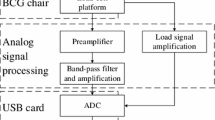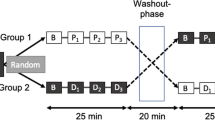Abstract
Short and long-term alterations of ballistocardiographic parameters (BCG) were studied in a sitting position using Electromechanical Film (EMFi) sensors. Several physiological parameters were recorded from 48 men of middle age in consecutive recordings and after a 2-week interval. The duration and amplitudes of the signal components were studied. The repeatability index R, the Pearson correlation, and Bland–Altman (BA) repeatability methods were used to determine how repeatable the studied signals are. In consecutive and during 2 week recordings, the Pearson correlation rates for BCG systolic component values (from 0.88/0.83 (T RJ) to 0.97/0.78 (A IJ), PWV values for the left 0.97/0.67 and right ankle 0.98/0.76) were detected indicating excellent repeatability during consecutive recordings. Respectively BA T RJ was −0.002 ± 0.028/−0.004 ± 0.030. Corresponding R values were T RJ 0.90/0.82 and right ankle PWV 0.98/0.81. Quite modest blood pressure R values were obtained between 2 week recordings (systolic 0.63, diastolic 0.75, and heart rate 0.59). BCG and PWV measured with EMFi sensors are highly repeatable in consecutive recordings. In longer time interval recordings, BCG is influenced by hemodynamic instability, but in spite of this the reproducibility of the main parameters of the BCG and PWV were better than measured heart rate and blood pressure values.





Similar content being viewed by others
References
Alametsä J (2004) The possibilities of EMFi sensors in heart related activity monitoring with a new mobile physiological signal measurement station. In: Linden G (ed) Proceedings of the proactive computing workshop PROW, Helsinki, 25–26 Nov 2004
Brotmacher L (1956) The normal ballistocardiogram. Br Heart J 18:145–152
Brown HR, DeLalla V, Epstein MA, Hoffman MJ (1952) The normal ballistocardiogram. In: Clinical Ballistocardiography. The Macmillan Company, New York, pp 53–68
Cunningham DM (1970) Specifications for the ultra-low-frequency ballistocardiograph. Bibl Cardiol 26:343–353
Erina YeV (1960) The significance of the time interrelationships in ballistocardiographic analysis. (25 October 1960: ADA377004, Joint Publications Research Service Arlington) translation of Terapevticheskiy Arkhiv 32(5):77–85
Faire U, Theorell TA (1979) A simple ballistocardiographic measure (IJ/HI amplitude ratio) in relation to electrocardiographic evidence of ischaemic heart disease. Scand J Clin Lab Invest 39:435–440
Gersak G, Zemva A, Drnovsek J (2009) A procedure for evaluation of non-invasive blood pressure simulators. Med Biol Eng Comput 47:1221–1228
Gubner RS, Rodstein M, Ungerleider HE (1953) Ballistocardiography—an appraisal of technic, physiologic principles, and clinical value. Circulation 7:268–286
Harrison WK, Taylor HL (1983) Effects of exercise on aging trends in cardiovascular dynamics. Age 6:42–45
Hefferman KS, Rossow L, Jae SY, Shokunbi HG, Gibson EM, Fernhall BO (2006) Effect of single-leg resistance exercise on regional arterial stiffness. Eur J Appl Physiol 98:185–190
Kirjavainen K (1987) Electromechanical film and procedure for manufacturing same. US Patent 4654546. Manufacturer of EMFi: Emfitech Ltd, Vaajakoski, Finland
Klabunde RE (2005) Cardiovascular physiology concepts. Lippingcott Williams and Wilkins, Philadelphia, p 95
Kuo PT, Schnabel TG, Kay CF (1952) On certain abnormal ballistic complexes: their relationships to other mechanical and electrical events of the cardiac cycle. Circulation 6(1):74–81
Millasseau SC, Ritter JM, Takazawa K, Chowiencyk PJ (2006) Contour analysis of the photoplethysmographic pulse measured at the finger. J Hypertens 24:1449–1456
Niiranen TJ, Jula AM, Kantola IM, Kähönen M, Reunanen A (2009) Home blood pressure has a stronger association with arterial stiffness than clinic blood pressure: the Finn-Home Study. Blood Press Monit 14(5):196–201
Noordergraaf A (1956) Physical basics of ballistocardiography. S-Gravenhage, Excelsior, pp 104–124
Pollock P (1957) Ballistocardiography: a clinical review. Can Med Assoc J 76(9):778–783
Rangayyan RM (2000) A case-study approach to solve problems in biomedical signal analysis. Version: March 13. The IEEE Press, Piscataway, p 31
Reeves TJ, Jones WB, Hefner LL (1957) Design of an ultra low frequency force ballistocardiograph on the principle of the horizontal pendulum. Circulation 16:36–42
Soames RW, Atha J (1982) Three-dimensional ballistocardiographic responses to changes of posture. Clin Phys Physiol Meas 3(3):169–177
Starr I, Hildreth EA (1952) The effect of aging and of the development of disease on the ballistocardiogram: a study of eighty subjects, originally healthy, followed ten to fourteen years. Circulation V(4):481–495
Stergiou GS, Lourida P, Tzamouranis D, Baibas NM (2009) Unreliable oscillometric blood pressure measurement: prevalence, repeatability and characteristics of the phenomenon. J Hum Hypertens 23:794–800
Talbot S, Harrison WK (1955) Dynamic comparison of current ballistocardiographic methods: part I: artefacts in the dynamically simple ballistocardiographic methods. Circulation 12:577–587
Tannenbaum O, Shack JA, Vesell H (1952) Relationship between ballistocardiographic forces and certain events in the cardiac cycle. Circulation 6:586–592
Tanner JM (1949) The construction of normal standards for cardiac output in man. J Clin Invest 28:567
Thompson WP, Rappaport MB, Sprague HB (1953) The normal ballistocardiogram. Circulation 7:321–328
Wade EG, Fulton RM, Mackinnon J (1956) The ballistocardiogram in the diagnosis of coronary arterial disease. Br Heart J 18:65–77
Weissler AM (1974) The Ballistocardiographic waveforms. In: Noninvasive cardiology monographs. Grune and Stratton Inc, New York, pp 39–148
Acknowledgments
This study was financially supported by the Finnish Cultural Foundation and the Wihuri Foundation who we wish to thank for their financial support. We also thank the measured persons for participating in this study.
Author information
Authors and Affiliations
Corresponding author
Appendix
Appendix
See Fig. 6.
First recording from case 39 (127/83 heart rate 61) on the left and second recording (2 weeks after the first one) on the right picture (133/82 heart rate 53) including ECG, seated BCG, CP tracings and the tracings from the wrist and ankle signals using EMFi sensor strips. Using the wrist and ankle signals, the propagation speed of the pulse wave can be accurately measured. Visually the tracings correspond mainly to each other except for the amplitude of the signals, which were in general smaller in all channels in the second recording when compared to the first one. The CP supplements the BCG data by indicating the exact place of the blood ejection from the left ventricle
Rights and permissions
About this article
Cite this article
Alametsä, J., Palomäki, A. & Viik, J. Short and longer term repeatability of ballistocardiography in a sitting position with EMFi sensor. Med Biol Eng Comput 49, 881–889 (2011). https://doi.org/10.1007/s11517-011-0746-y
Received:
Accepted:
Published:
Issue Date:
DOI: https://doi.org/10.1007/s11517-011-0746-y





